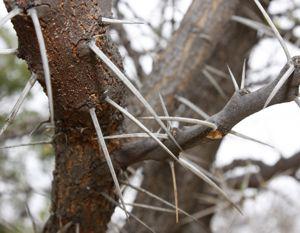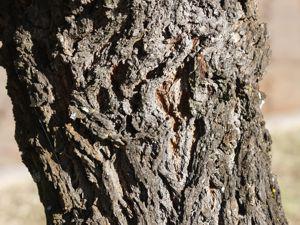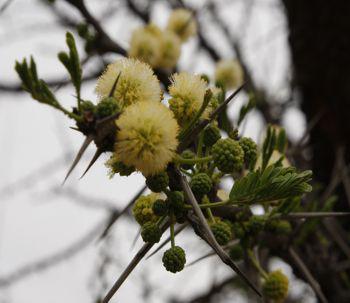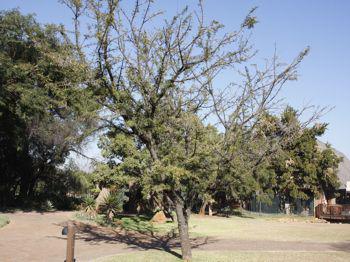Vachellia robusta subsp. robusta
Vachellia robusta (Burch.) Kyalangalilwa & Boatwright subsp. robusta
Family: Fabaceae
Common names: broadpod robust thorn (Eng.); enkeldoring (Afr.); mooka (Nso.); mvumbangwenya (Tso.); mokhu (Tsw.); muvumba-ngwena (Ven.);umngamanzi (Zul.)
SA Tree No: 183
Introduction
This is a small to medium, upright, deciduous thorn tree consisting of a narrow crown. The narrow upright growth and majestic stature, makes it one of the most popular thorn trees in southern Africa.

Description
Description
The broadpod robust thorn is a small to medium-sized tree, reaching up to 10 m (usually around 5–8 m) tall, with a slightly flattened crown. The main stem is grey to blackish with rough hairy branches. The white thorns are straight and paired.

The heartwood is pinkish brown to reddish brown and distinctly demarcated from the wide whitish sapwood. The texture is moderately coarse to coarse and even. The wood is brittle and moderately durable, being moderately susceptible to borer and termite attack; the sapwood is susceptible to sap-stain (sap-stain is usually caused by a fungus which discolours the wood).

Leaves are borne on woody cushions, twice-compound with 2–5 pairs of pinnae and 10–15 pairs of dark green and glossy leaflets.

Flowers are creamy white pompons produced in July–October, followed by the dehiscent greyish brown, straight and broad, seed pods adorning the tree from November–August.

Vachellia robusta grows fast. Trees are usually deciduous for a short period. Inflorescences usually appear together with or after the new leaves in spring.
Vachellia robusta is variable, and is subdivided into 3 subspecies:
- subsp. clavigera (narrowpod robust thorn), which may develop into a medium-sized tree and is characterized by its pubescent leaf rachis and curved, comparatively thin pods;
- subsp. robusta, which remains a small tree (up to 8 m tall) and is characterized by its glabrous leaf rachis and straight, comparatively wide pods;
- and subsp. usambarensis which is characterized by its glabrous leaf rachis and very narrow pods, although this sub-species range does not extend into southern Africa. Intermediates between the subspecies are rather common.
Conservation Status
Status
The threat status according to the 2009 Red List of both South African subspecies of Vachellia robusta are listed as LC (Least Concern), as they are not considered to be threatened: the population shows stability.
Distribution and habitat
Distribution description
Broadpod robust thorn occurs in a diverse range of habitats and is component of many plant communities. In southern Africa it is very common in the warm dry savannas, up to 1 800 m altitude. It is resistant to drought and frost. It is distributed from tropical Africa southwards to Namibia, Mozambique, Swaziland and South Africa: KwaZulu-Natal, Limpopo, Mpumalanga, Northern Cape and North West Provinces. Subsp. robusta and clavigera occur from Ethiopia and Somalia, south to Namibia and northern and eastern South Africa. It has been introduced elsewhere, e.g. in South Asia.
Derivation of name and historical aspects
History
This was previously known as Acacia robusta Burch. subsp. robusta. The specific name robusta refers to the robust nature of the species. This species was formerly included in the genus Acacia, but has since been moved to the genus Vachellia. Many books and field guides may still have the genus listed as Acacia.
Ecology
Ecology
Vachellia robusta is commonly found in open forests and woodlands, often near streams, where one can find large specimens. Leaves are browsed by kudu and other mammals. The strongly scented flowers attract bees and butterflies, and many other insects. The seed pods and leaves are eaten by herbivores which distribute the seed in their dung. The seeds are parasitized by Bruchid beetle larvae which eat the developing seed. Many birds will rifle through the dry seed pods looking for these beetle larvae. Birds such as Sparrows and Finches, like to build their nests in the densely thorny branches of this tree, as the thorns offer excellent protection from predators.
It is the larval host to Hutchinsons Silver-spot (Aphnaeus hutchinsonii) and possible larval host to Thorn-tree blue (Azanus moriqua), Velvet-spotted blue (Azanus ubaldus), Topaz-spotted blue (Azanus jesous) and the Black heart (Uranothauma nubifer) butterflies. Many other Lepidoptera species (butterflies and moths) are cited as breeding on unspecified species of Acacia which may include Vachellia robusta.
As with many plants in the pea family, Fabaceae, Vachellia robusta is modulated by nitrogen-fixing Rhizobium soil bacteria, which colonize inside the roots, where they fix atmospheric nitrogen (N2), which is unavailable to plants, and convert it to ammonia (NH4+). This is an available form of nitrogen usable by plants. The bacteria in turn benefit by having access to organic compounds that the plant produces through photosynthesis. This is referred to as an endosymbiotic relationship (both the plant and the bacteria benefit and it takes place inside the tissue of the plants).

Uses
Use
The wood is considered of rather poor quality but is sometimes used for making furniture, and shelving, although these uses are limited because of its strong tendency to warp. It is also used as firewood. The pulping properties of the wood have been rated as good.
In traditional medicine, the powdered root is applied to swellings, and a decoction of the roots is used to treat dysmenorrhea (pain during menstruation), infertility in women and bilharzia (schistosomiasis), whereas a decoction of the stem bark is used to treat gonorrhea, abdominal pain and skin conditions. The leaves are used to treat snake bites. Some medicinal applications of unknown parts of the tree have been reported to treat malaria and bubonic plague.
Vachellia robusta is commonly grown as an attractive garden tree and occasionally grown as a bonsai. Various species of weevils can attack the seeds, especially when on the ground.

Growing Vachellia robusta subsp. robusta
Grow
Germination of wild collected, untreated seed can be very low, often only about 3%; however, germination can be significantly improved by scarification. This happens in nature when the seeds are eaten by herbivores or seeds lay in the soil for few to several years, decaying the seed coat. Seeds for propagation should be harvested in the treetops, and can be stored if kept dry and cool. Seeds can be scarified in the nursery by rubbing them on rough sandpaper or other suitably rough surface, to scratch the cuticle.
The seed is then covered with warm water and left to cool and soak for 24 hours. After this, the swollen seeds can be planted in a mixture of compost and river sand, at a depth of approximately 5–10 mm, and covered with the sifted compost and sand mixture. Germination is quick, often within a couple of days in spring and summer; seedlings can be planted out into individual containers once they reach the two-leaf stage. Saplings can be planted out into open ground after one or two years, and should be watered regularly until well established.
This species can provide a spectacular display when flowering and are very good garden trees, even in frost-prone regions.
References
- Boon, Richard. 2010. Pooley's trees of eastern South Africa, a complete guide. Flora & Fauna Publications Trust, Durban.
- Coates Palgrave, K. 2013. Trees of southern Africa, Edn 2. Struik Publishers: Cape Town.
- Kyalangalilwa B, et al. 2013. Phylogenetic position and revised classification of acacia s.l.(Fabaceae Mimosoideae) in Africa, including new combinations of Vachellia and Senegalia. Botanical Journal of Linnean Society 172,500-523.
- Palmer, E. & Pitman, N. 1972. Trees of southern Africa. Balkema, Cape Town.
- Raimondo, D. et al. 2009. Red list of South African plants. Strelitzia 25. SANBI (South African National Biodiversity Institute), Pretoria.
- Schmidt, E., Lötter, M. & McCleland, W. 2002. Trees & shrubs of Mpumalanga and Kruger National Park. Jacana, Johannesburg.
- Coates Palgrave, K. 2013. Trees of southern Africa, Edn 2. Struik Publishers: Cape Town.
- Van Wyk, Braam, A.E & Van Wyk, P. 2013. Field guide to trees of southern Africa. Struik, Cape Town.
- Venter, F. & Venter, J.A. 2012. Making the most of indigenous trees. Briza Publications, Pretoria.
- http://en.wikipedia.org/wiki/Rhizobium
- http://en.wikipedia.org/wiki/Dysmenorrhea
- http://archive.bio.ed.ac.uk/jdeacon/FungalBiology/sapstain.htm
Credits
Thabang Mokobori and Andrew Hankey
Walter Sisulu National Botanical Garden
September 2015
Plant Attributes:
Plant Type: Tree
SA Distribution: Eastern Cape, Free State, Gauteng, KwaZulu-Natal, Limpopo, Mpumalanga, North West, Northern Cape
Soil type: Sandy, Clay, Loam
Flowering season: Spring, Early Summer
PH: Neutral
Flower colour: White, Cream
Aspect: Full Sun
Gardening skill: Easy
Special Features:
Horticultural zones










Rate this article
Article well written and informative
Rate this plant
Is this an interesting plant?
Login to add your Comment
Back to topNot registered yet? Click here to register.